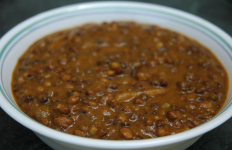
|
HIMACHAL’SLITTLE DROPS OF GOLD: MAAHNI (CHANAA CURRY)
By GM for The Planet Food
Our paternal grandparentslived in a breathtakingly beautiful region of India known as Himachal Pradesh.When I say breadth taking, I mean the kind of place, where the sky is clearblue with a whole galaxy of stars visible every night, and the air is so purethat, you can actually feel it the moment you enter the region by road (there’sa stark difference in temperature and the sheer comfort of breathing). Goingthere as kids, we went through a travel regime, which today, sitting in myurban domain, seems very rigorous. But in those days, walking 7- 8 miles througha hilly terrain with bag packs, wading through waist deep streams of water andall of this, after 14 hours of travel by bus through 3 states, was anexcitement we looked forward to each summer! I mean honestly, it’s not everyday that you can stop mid-stream in crystal clear flowing water and stare atbeautiful fish and aquatic beings all minding their own business as you walkacross two mountains. Our only pit stop was for pyaaz pakodaas (deep friedonion and gram flour cutlet like snacks) at a tiny local shop at the start ofour journey, which remains there even today, albeit much bigger now. WhileHimachal has truly come a long way since then, I'm not sure if I love the newdeveloped tourist capital of India as much as I did the quaint little gems ofthe north back then. It remains the land of His Holiness the Dalai Lama, whose Ashramis nestled in the northern peak of Dharamsala, visited each year by millions ofIndian and foreign tourists in search of spiritual and cultural enlightenment.
Once we reachedour destination, all we could think of was a hearty wood stove meal cooked inour grandma’s big kitchen with the family sitting around the fire. The mostamazing part of the meal was its rustic and truly punch-filled flavours derivedfrom the hand ground spices that our grandma used in her cooking. I have toadmit, I wasn’t quite sure back then why she would spend such effort and timetrying to grind garlic, chillies, onions, coriander seeds and the like in a bigstone pounder rather than just chop them or use the electric grinder lying withher. But, many years later, I realised the answer to that and, I felt a deepfound appreciation for her recipes and cooking. The magic that these, so tosay, ‘old style’ preparations add to the flavour of food is really unmatched eventoday. Meals there were strictly vegetarian through our 3-4 weeks of stay,which was bit of an effort initially, but soon became a much enjoyed way ofbeing. The only food ‘cheating’ we indulged in (our parents included in theconspiracy) was, sneaking in tinned meat for our little pet, a toy poodle, whohimself drew a lot of attention from the local kids especially, because of histiny size, children’s clothing and the ridiculous baskets my mum would carryhim in. All these memories bring back amazing tastes of food, my favourite amongstwhich was a black gram dish gravy called, ‘Maahni’, which I’m preparing today asper my grandma’s recipe with some method alterations (owing to the lack ofvessels and tools which she used in her kitchen).
Maahni is a sweet and sourblack chanaa (whole Bengal gram) curry, eaten with rice. Normally dried rawmango pieces (known as ‘Bukadis’) are used for its typical tangy and sour taste,but as these are not easily available outside Himachal, dry mango powder (amchur)can be used as an alternative. Thesedishes are all the more special as we did not find them in any restaurant outsideHimachal and even at home, we had them on rare occasions as many of theingredients were difficult to find so, they were treasured for special days. Eventoday, despite the vast variety of very uniquely flavoured dishes, Himaachali cuisineremains very less explored in India (leave alone outside India). Almost allIndians (like their foreign counterparts) only come up with Mughlai food, when they think NorthIndian cuisine, as this is the most readily available form of food from NorthIndia and is so over exploited in restaurants across the length and breadth ofthe country. While I do enjoy Mughlai food, I prefer having a chance to explorethe varied flavours of food, spread across this vast multi-cultural country ofours, which really has so much more to offer across its huge geographical extent,spanning centuries of well-kept food traditions. Himachali cuisine forinstance, offers a lighter, less spicier option to its Mughlai cousin, with suchuniquely flavoured food options, that are difficult to ignore when visitingthis beautiful land, both as a (privileged) vegetarian or as a hard corenon-vegetarian.
Recipe:
Time: 35 – 40 minutes
Serves: 4
Ingredients:
-
Besan (Gram Flour): 1 cup
-
Amchur (Dry Mango Powder): 1/2cup
-
kala chana (whole Bengal Gram):1 cup
-
Mustard oil: 2 Table Spoon
-
Red Chillies: 2
-
Red chilli powder: 1/2 TeaSpoon
-
Turmeric powder: 1 TeaSpoon
-
Cumin Seeds: 1 Tea Spoon
-
Meethi Saunf (Ani/Fennelseeds): 2 Tea Spoon
-
Shakkar (JaggeryPowder): 1/2Cup
-
Chhuara (Dry Dates): 6
-
Salt: As per taste
Cooking :
-
Soak black grams overnight
-
Pressure cook the black gram /chana next morning with salt as per taste, till cooked, but not over cooked
-
Strain and keep its waterseparately to be used in the curry later
-
Soak dry dates for about anhour in hot water
-
Cut into long pieces(4 pieceseach date)
-
Mix besan (Gram Flour),Jaggerypowder, chilli powder and Amchur (dry mango powder) in sufficient water, ensuring smoothness bystirring well into thin curry .
-
Heat mustard oil in a pan
-
Add aniseeds ,cumin seeds andred chillies and saute till aniseeds and cumin seeds turn brown and Addturmeric powder
-
Add boiled Kala chana and drydate pieces
-
Add besan mixture curry, keep stirring for about 30minutes or till brown (curry should not have a thick consistency)
-
Close the gas as the dish isready
Serve warm withboiled rice or chapaattis
|